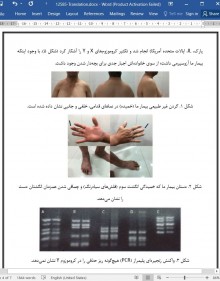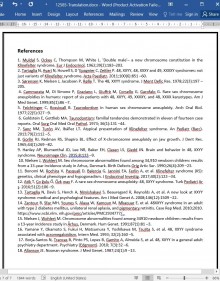
دانلود مقاله یک مورد سندروم 48 XXYY با ناباروری طولانی مدت و بدشکلی های گردن
چکیده
پیش زمینه: عوامل متعددی ممکن است در ناباروری طولانی مدت نقش داشته باشند؛ علت ژنتیکی این ناباروری به دلیل علائم مورفولوژیک یا اندوکرینی غیر اختصاصی خود بیشتر از سایر عوامل نادیده گرفته شده است. ما یک مورد نادر از نارسایی پیشرونده ی بیضه را در یک بیمار گزارش می کنیم که به دلیل سندروم 48xxyy به وجود آمده است.
معرفی بیمار: یک مرد 39 ساله ی عرب برای درمان ناباروری به کلینیک باروری ما مراجعه کرد. ناباروری اولیه در او تشخیص داده شد؛ او به دلیل 20 سال ناباروری مراجعه کرده بود. بیمار ما ویژگی های مورفولوژیکی غیر اختصاصی همانند یک گردن پهن غیر طبیعی با خمیدگی رو به جلو، خمیدگی انگشت سوم و ویژگی های هیپوآندروژنمی متوسط را نشان می داد. آنالیز مایع منی، وجود آزوسپرمی را آشکار کرد. تست های ژنتیکی که برای تشخیص آزوسپرمی انجام شدند؛ از جمله تشخیص ناحیه ی تعیین کننده ی جنسیت کروموزوم Y (SRY) و ریز حذف کروموزوم Y هیچ گونه حذفی را در کروموزوم Y نشان ندادند. روش کاریوتایپینگ مورد استفاده قرار گرفت و سندروم 48XXYY در بیمار ما تشخیص داده شد.
نتیجه گیری: تست های ژنتیکی (کاریوتیپ و تست هایی از این قبیل) نقش مهمی را در تشخیص بیمار ما که به ناباروری طولانی مدت ناشی از سندروم 48XXYY مبتلا بود؛ ایفا کردند و باید نقش حیاتی در تشخیص تمام موارد ناباروری طولانی مدت به خصوص زمانی که بیماران با علائم اندوکرینی، اسکلتی یا مورفولوژیکی مراجعه می کنند که این علائم حاکی از یک علت ژنتیکی زمینه ای است؛ داشته باشد.
پیش زمینه
سندروم 48XXYY اولین بار در یک متن پزشکی در سال 1960 میلادی توسط مولدال و همکارانش (1) به عنوان یک آنیوپلوئیدی و نوعی از سندروم کلاین فلتر (48XXYY) تعریف شد. با وجود اینکه از نظر فنوتیپ شبیه به سندروم کلاین فلتر است و هر دو ویژگی های مشترکی مانند هیپرگنادوتروپیک هیپوگنادیسم دارند؛ اما سندروم 48XXYY از طریق علائمی مانند عقب ماندگی ذهنی و اختلالات روانپزشکی تشخیص داده می شود. بعد از آن در طول حیات فرد، سندروم با علائمی همچون چاقی شکمی، بیضه های کوچک، تاخیر در رشد، اختلالات رفتاری، ناتوانی در یادگیری و تاخیر در بلوغ جنسی و علائمی که تا زمان بلوغ جنسی اولیه بروز نمی کنند؛ تظاهر می کند. بدشکلی های اسکلتی نیز در سندروم 48XXYY گزارش شدند و ممکن است شامل بهم چسبیدن زند زیرین و زبرین، پوکی استخوان، کلفت شدن ناهنجار استخوان ها، اپی فیز کاذب، گوژپشتي مخلوط با انحناي طرفي ستون مهره ها و کلفت شدن استخوان پیشانی باشد.
نتیجه گیری
بیمار ما به یک مورد نادر از ناباروری اولیه ی بلند مدت و نارسایی پیشرفته بیضه ناشی از سندروم 48XXYY مبتلا بود. تشخیص اولیه ممکن است گزینه های درمانی زیادی را قبل از رسیدن به مرحله ی نهایی نارسایی بیضه ارائه دهد. آزمایش ژنتیک (کاریوتیپ و غیره) نقش حیاتی را در تمام موارد ناباروری اولیه ی طولانی مدت به خصوص زمانی که با علائم اندوکرینی، اسکلتی، مورفولوژیکی یا تکاملی همراه است که می تواند بیانگر یک علت ژنتیکی زمینه ای باشد؛ ایفا می کند.
Abstract
Background: Long-term infertility can be attributed to many factors, with the genetic factor being the most overlooked due to its many nonspecific morphological or endocrine signs. We present a rare case of a patient with progressive testicular failure associated with 48,XXYY syndrome.
Case presentation: A 39-year-old Arab man presented to our fertility clinic for fertility treatment. He was diagnosed with primary infertility, which had been present for 20 years at the time of presentation. Our patient had nonspecific morphological features of an abnormally wide neck with front slouching neck posture, clinodactyly of the third finger, and had moderate hypoandrogenemic features. A semen analysis revealed azoospermia. Genetic tests for azoospermia, including sex-determining region Y (SRY) detection and chromosome Y microdeletion, revealed no deletion present on the Y chromosome. Karyotyping was used and our patient was diagnosed with 48,XXYY syndrome.
Conclusion: Genetic testing (karyotyping and so on) played a key role in the diagnosis of our patient with long-term primary infertility secondary to 48,XXYY syndrome, and should play a vital role in all cases of long-term infertility, especially when presentation is accompanied by endocrine, skeletal, or morphological symptoms, signifying an underlying genetic factor.
Background
48,XXYY syndrome was first described in the medical literature in 1960 by Muldal et al. [1] as an aneuploidy and a type of Klinefelter syndrome (47,XXY). Although phenotypically similar to Klinefelter syndrome, sharing features like hypergonadotropic hypogonadism [2], it is made distinct by symptoms of mental retardation and psychiatric disorders [3, 4]. The syndrome manifests later on in life with abdominal adiposity, small testicles, delayed development, behavioral disorders, learning disabilities, and delayed puberty, with such symptoms not presenting until early puberty [5–7]. Skeletal deformities were reported for 48,XXYY syndrome and could include radio-ulnar synostosis, osteoporosis, hyperostosis, pseudoepiphysis, kyphoscoliosis, and frontalis interna [8].
Conclusions
Our patient had a rare case of long-term primary infertility and progressive testicular failure secondary to 48, XXYY syndrome. Early diagnosis may have provided many treatment options before reaching the end stage of testicular failure. Genetic testing (karyotyping, and so on) plays a vital role in all cases of primary infertility presenting in the long term, especially when presentation is accompanied by endocrine, skeletal, morphological, or developmental symptoms, which could signify an underlying genetic factor.
چکیده
پیش زمینه
گزارش مورد
بحث
نتیجه گیری
منابع
Abstract
Background
Case presentation
Discussion
Conclusions
References
- اصل مقاله انگلیسی با فرمت ورد (word) با قابلیت ویرایش
- ترجمه فارسی مقاله با فرمت ورد (word) با قابلیت ویرایش، بدون آرم سایت ای ترجمه
- ترجمه فارسی مقاله با فرمت pdf، بدون آرم سایت ای ترجمه



